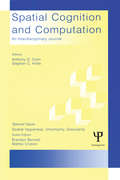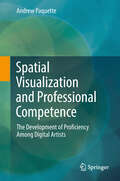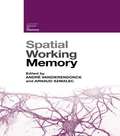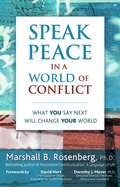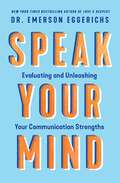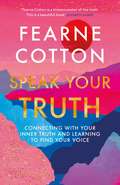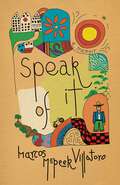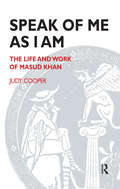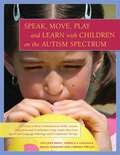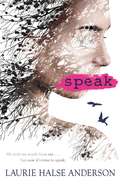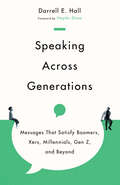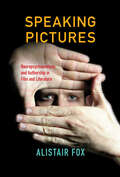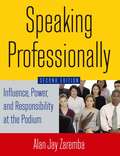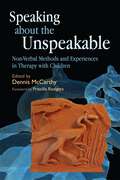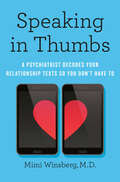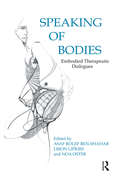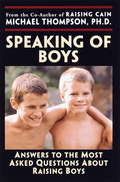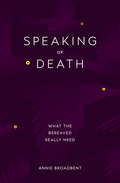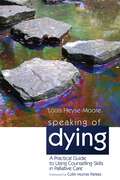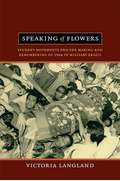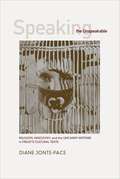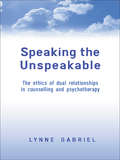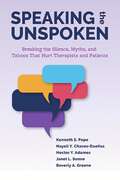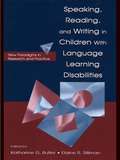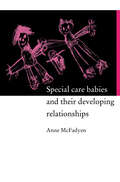- Table View
- List View
Spatial Vagueness, Uncertainty, Granularity: A Special Double Issue of spatial Cognition and Computation
by Brandon Bennett Matteo CristaniThis special issue collects enhanced and extended versions of papers that were presented at the Symposium on Spatial Vagueness, Uncertainty, and Granularity held in October 2001. The contributions examine fundamental problems in the analysis of spatial vagueness and uncertainty, and the editors hope this selection stimulates further investigation in this growing subfield of the theory of spatial information.
Spatial Visualization and Professional Competence: The Development Of Proficiency Among Digital Artists
by Andrew PaquetteThe computer graphics (CG) industry is an attractive field for undergraduate students, but employers often find that graduates of CG art programmes are not proficient. The result is that many positions are left vacant, despite large numbers of job applicants. This book investigates how student CG artists develop proficiency. The subject is important to the rapidly growing number of educators in this sector, employers of graduates, and students who intend to develop proficiency for the purpose of obtaining employment. Educators will see why teaching software-oriented knowledge to students does not lead to proficiency, but that the development of problem-solving and visualisation skills do. This book follows a narrow focus, as students develop proficiency in a cognitively challenging task known as ‘NURBS modelling’. This task was chosen due to an observed relationship between students who succeeded in the task, and students who successfully obtained employment after graduation. In the study this is based on, readers will be shown that knowledge-based explanations for the development of proficiency do not adequately account for proficiency or expertise in this field, where visualisation has been observed to develop suddenly rather than over an extended period of time. This is an unusual but not unique observation. Other studies have shown rapid development of proficiency and expertise in certain professions, such as among telegraph operators, composers and chess players. Based on these observations, the book argues that threshold concepts play a key role in the development of expertise among CG artists.
Spatial Working Memory (Current Issues in Memory)
by André Vandierendonck Arnaud SzmalecSpatial working memory is the ability to remember the location in which something is perceived, and in addition, the ability to recall a series of visited locations. In this book, top researchers in the domain of spatial working memory review and discuss findings about the processes and memory structures which underlie the ability to store and use spatial information. The first part of the book provides an examination of the working memory system, looking at the behavioural and neural processes involved in working with (visuo-) spatial information and how these can constrain the hypotheses that are generated. It also addresses methodological questions, for example looking at how the use of the appropriate method can ensure that the observed data are as informative as possible about the underlying structures. The remaining chapters focus on specific problems to do with spatial working memory such as how the working memory system can handle individual differences in representing spatial interactions, how the visuospatial system can support and interact with the environment and the verbal system, and how understanding these systems can shed light on the development of particular skills in children with developmental disorders. With contributions from leading international figures in the field, this book is the first to address the topic of spatial working memory from a range of theoretical and methodological perspectives. As such, it will serve as an indispensible tool for students and researchers interested in working memory.
Speak Peace in a World of Conflict: What You Say Next Will Change Your World
by Marshall B. RosenbergWords have the power to create profound healing -- or incredible suffering -- and yet even with the best intentions it can be difficult to build harmony and trust through speech. This pioneering text presents a four-part model for immediately connecting words with peace and well-being in relationships. Applying the principles of Nonviolent Communication to conversation, the book seeks to answer the two central questions of How can we express what's alive in us? and How can we make life more wonderful? Chapters discuss using natural empathy to ease stressful situations and beat fear, thus avoiding dehumanising communication patterns, and instead seeing through the eyes of others to foster understanding. Examples of applications in education, correctional facilities, parenting, and the business world are given. This instructive guide teaches users of all types that it is possible to meet their needs and the needs of others in a compassionate manner, beginning with the very first words they use.
Speak Your Mind: Evaluating and Unleashing Your Communication Strengths
by Dr. Emerson EggerichsSay goodbye to misunderstandings and hello to meaningful connections.From bestselling author, Dr. Emerson Eggerichs comes an invigorating approach to communication in our modern, digital era—where every interaction can shape our lives. Whether you&’re chatting with a friend, emailing a coworker, or having a heart-to-heart talk with your spouse, miscommunication can result in hurt feelings and misunderstanding.Speak Your Mind is your guide to navigating daily conversations with confidence, wisdom, and clarity. This book will help you master the art of communicating by teaching you to consider four essential questions before you speak or write:Is it true?Is it kind?Is it necessary?Is it clear?By sincerely engaging with these questions, you will begin unlocking the secrets of powerful communication, ensuring you say what you mean and mean what you say.Speak Your Mind, an inspired and revised update of Before You Hit Send, features a new survey offering personalized recommendations to help you lean into your communicative strengths and pinpoints areas for growth.Unlock the power of clear communication today!
Speak Your Truth
by Fearne Cotton'Fearne Cotton is a tireless seeker of the truth, and a wonderful communicator of sanity, hope, and (most refreshingly of all) reality. This is, simply put, a beautiful book.' Elizabeth Gilbert, author of Eat, Pray, Love and Big Magic
Speak of It: A Memoir
by Marcos McPeek VillatoroIn the face of clashing family backgrounds and sexual abuse as a child, Marcos's extraordinary memoir maps his journey through self-discovery, from his Salvadoran-Appalachian parentage to his success as a writer, his mental illness, and his healing in an extraordinary memoir.In Speak of It, Marcos McPeek Villatoro explores how he channeled his Latino roots to come to terms with the childhood sexual abuse he suffered at the hands of a relative in his home in Appalachia, and he recounts his ensuing struggle with trauma and mental illness.The son of a Salvadoran mother and a Scotch Irish father, Marcos spent much of his life struggling to break away from the trauma he experienced in childhood by striving to get closer to his Salvadoran heritage. His journey includes steeping himself in the Spanish language and Latin American literature, especially the work of Gabriel García Marquez; a stint in Nicaragua with Witness for Peace, followed by missionary work in Guatemala; and social-justice work with Mexican migrant farmworkers in Alabama. Each experience brought him closer to understanding where he came from and to forging an identity as a whole self in the wake of trauma.Riveting, horrifying, moving, and inspiring, Speak of It is a testament to the healing power of language, books, and identity.
Speak of Me As I Am: The Life and Work of Masud Khan
by Judy CooperThis book unravels the many enigmas and perplexities of Masud Khan's intriguing personality. It is a work of exquisite scholarship based on careful scrutiny of unpublished documents and extensive interviews with those who knew Khan intimately.
Speak, Move, Play and Learn with Children on the Autism Spectrum: Activities to Boost Communication Skills, Sensory Integration and Coordination Using Simple Ideas from Speech and Language Pathology and Occupational Therapy
by America X. Gonzalez Lois Jean Brady Maciej Zawadzki Corinda PresleyThis practical resource is brimming with ideas and guidance for using simple ideas from speech and language pathology and occupational therapy to boost communication, sensory integration, and coordination skills in children on the autism spectrum. Suitable for use in the classroom, at home, and in community settings, it is packed with easy-to-follow, goal-oriented activities and lesson plans centering around arts and crafts, music-making, cookery, sensory activities, and skills for daily living. The activities all use materials and objects which are readily available in the home or classroom, and can easily be adapted to suit children of different abilities, including those who are non-verbal. This book is perfect for teachers, speech and language pathologists, and occupational therapists who need fresh and effective activity ideas for the classroom or therapy room, as well as for parents and other caregivers who want to help their child on the autism spectrum to speak, move, play...and learn!
Speak: The Graphic Novel
by Laurie Halse AndersonA fiercely authentic, critically acclaimed and award-winning modern classic.'Speak up for yourself - we want to know what you have to say.'From my first day at Merryweather High, I know this is a lie.Nobody will even talk to me, let alone listen - all because I called the cops on an end-of-summer party.But if I could only tell everyone why I called the police that night...If I could explain what happened to me... If I could speak...Then everything might change.'With the rise of women finding their voices and speaking out about sexual assault in the media, this should be on everyone's radar... Powerful, necessary, and essential.' - Kirkus
Speaking Across Generations: Messages That Satisfy Boomers, Xers, Millennials, Gen Z, and Beyond
by Darrell E. HallDifferent generations communicate differently.
Speaking Pictures: Neuropsychoanalysis and Authorship in Film and Literature
by Alistair FoxA new way to understand the human longing for stories, informed by both neuroscience and psychoanalytic theory.In this book, Alistair Fox presents a theory of literary and cinematic representation through the lens of neurological and cognitive science in order to understand the origins of storytelling and our desire for fictional worlds.Fox contends that fiction is deeply shaped by emotions and the human capacity for metaphorical thought. Literary and moving images bridge emotional response with the cognitive side of the brain. In a radical move to link the neurosciences with psychoanalysis, Fox foregrounds the interpretive experience as a way to reach personal emotional equilibrium by working through autobiographical issues within a fictive form.
Speaking Professionally: Influence, Power and Responsibility at the Podium
by Alan Jay ZarembaUpdated with new and current examples throughout, this concise guide is a rich resource for anyone who wants to become more effective in speaking settings. It covers all the basics and identifies essential principles that will help readers to efficiently prepare, deliver, and evaluate presentations.
Speaking about the Unspeakable: Non-Verbal Methods and Experiences in Therapy with Children
by Dennis Mccarthy Patricia Brescia Patti Knoblauch Jenny Bates Noelle Ghnassia-DamonChildren do not always have the capacity or need to express themselves through words. They often succeed in saying more about their feelings and experiences by communicating non-verbally through play and other expressive, creative activities. The basic premise of Speaking about the Unspeakable is that life's most pivotal experiences, both good and bad, can be truly expressed via the language of the imagination. Through creativity and play, children are free to articulate their emotions indirectly. The contributors, all experienced child therapists, describe a wide variety of non-verbal therapeutic techniques, including clay, sand, movement and nature therapy, illustrating their descriptions with moving case studies from their professional experience. Accessible and engaging, this book will inspire child psychologists and therapists, art therapists and anyone with an interest in therapeutic work with children.
Speaking in Thumbs: A Psychiatrist Decodes Your Relationship Texts So You Don't Have To
by Mimi WinsbergAn essential look at the love language of texts, helping you decipher the personalities of online daters, the subtle signals from your romantic partner, and the red flags hiding in plain sight.When it comes to modern relationships, our thumbs do the talking. We swipe right into a stranger's life, flirt inside text bubbles, spill our hearts onto the screen, use emojis to convey desire, frustration, rage. Where once we pored over love letters, now we obsess over response times, or wonder why the three-dot ellipsis came . . . and went.Nobody knows this better than Dr. Mimi Winsberg. A Harvard- and Stanford-trained psychiatrist, she cofounded a behavioral health startup while serving as resident psychiatrist at Facebook. Her work frequently finds her at the intersection of Big Data and Big Dating. Like all of us, Winsberg has been handed a smartphone accompanied by the urgent plea: "What does this mean?" Unlike all of us, she knows the answer. She is a text whisperer.Speaking in Thumbs is a lively and indispensable guide to interpreting our most important medium of communication. Drawing from of-the-moment research and a treasure trove of real-life online dating chats, including her own, Winsberg helps you see past the surface and into the heart of the matter. What are the hallmarks of healthy attachment? How do we recognize deception? How can we draw out that important-but-sensitive piece of information--Do you want kids? Do you use drugs? Are you seeing someone else?--without sending a potential partner heading for the hills?Insightful, timely, and impossible to put down, Speaking in Thumbs is an irresistible guide to the language of love. With wit and compassion, Winsberg empowers you to find and maintain real connection by reading between the lines.
Speaking of Bodies: Embodied Therapeutic Dialogues
by Liron LipkiesWhile the body has received significant attention in psychoanalysis and psychotherapy in the last couple of decades, this still focused primarily on the body of pathology - the body as speaking for (or on behalf of) the mind. Here, leading psychoanalysts and psychotherapists join with experts whose field is the body to examine and celebrate generative, creative, vital, and irreducible aspects of our embodiment. The book is divided into seven themes, each including a chapter by a therapist and another by a specialist pondering various aspects of the body. Fashion journalists speak with a relational psychotherapist about beauty, a chef discusses sensuality with a couple therapist, and a Rabbi and a psychoanalyst speak of divinity and the body. This is a book aimed at igniting our imagination and faith in the possibility of living a full embodied life, and of integrating such practices within therapeutic and psychoanalytic work.
Speaking of Boys: Answers to the Most-Asked Questions About Raising Sons
by Michael Thompson Teresa BarkerMy eight-year-old son is the only boy in his class who doesn't have a Gameboy. I don't want him to be ostracized for not having one, but I worry that it's addictive. What do you think? Our two sons are eleven and fourteen, and they are fiercely competitive. The tension around our house is awful. How can we help them get along better? We've worked very hard to keep our ten-year-old son in touch with his feelings. Sometimes it seems as if we've put him at a disadvantage, surrounded by tougher boys who can be pretty cruel with teasing. How can we help him protect himself when other boys start to tease? With his bestselling book Raising Cain, Michael Thompson, Ph. D. , at last broke the silence surrounding the emotional life of boys and spearheaded an important national debate. His warmth and humor quickly made him a popular and respected international speaker and consultant. Now he directs his authority, insight, and eloquence to answering your questions about raising a son. With candid questions and thoughtful, detailed responses, Speaking of Boys covers hot-button topics such as peer pressure, ADHD/ADD, and body image as well as traditional issues such as friendship, divorce, and college and career development. This perceptive, informative, and passionate book will leave you not only with useful, practical advice but also with the comforting knowledge that other parents share the same concerns you do when it comes to raising our boys into well-adjusted, responsible men. From the Trade Paperback edition.
Speaking of Death: What the Bereaved Really Need
by Annie Broadbent'To support the bereaved, we need to get to grips with death.'Talking about death and grief has become something of a modern taboo. Most of us would rather avoid the subject altogether because it makes us feel anxious or awkward. When Annie Broadbent's mum died, one of the hardest parts of her experience was seeing her friends and extended family paralysed by their fear of saying or doing the wrong thing.Frustrated and saddened by her own experience, in this thoughtful book Annie presents sixteen stories which build a much needed bridge between the bereaved and the rest of us. Combined with expert advice, Speaking of Death is a collection of real life experiences of grief. The stories help you build your own relationship with death and provide support for supporters of the bereaved. If you've never known what to say to a grieving person, you will after this book.'Annie offers a compassionate and caring approach to supporting someone through grief, developed through her own experience and the use of expert advice . . . this book will be a helpful tool for everyone' Shelley Gilbert, CEO of Grief Encounter'Wonderfully moving, relevant and important' Kate Timperley, Maggie'sThis book was first published as We Need to Talk About Grief.
Speaking of Dying: A Practical Guide to Using Counselling Skills in Palliative Care
by Louis Heyse-Moore Colin Murray ParkesGood counselling skills are often not taught to the professionals who need them most. Compassionate and tactful communication skills can make the difference between an awkward encounter with a dying patient, and an engaging, empathic bond between two people. Louis Heyse-Moore draws on his wealth of experience as a trained counsellor and palliative medicine specialist. Covering difficult subjects such as breaking the news of terminal illness to a patient, euthanasia and the effect of working with patients on carers, Speaking of Dying is a practical guide to using counselling skills for all clinical disciplines working in palliative care, whether in a hospice, hospital or at home. Complete with a clear explanation of both counselling and medical terminology, this hands-on guide will be an invaluable companion to anyone working in palliative care.
Speaking of Flowers: Student Movements and the Making and Remembering of 1968 in Military Brazil
by Victoria LanglandSpeaking of Flowers is an innovative study of student activism during Brazil's military dictatorship (1964-85) and an examination of the very notion of student activism, which changed dramatically in response to the student protests of 1968. Looking into what made students engage in national political affairs as students, rather than through other means, Victoria Langland traces a gradual, uneven shift in how they constructed, defended, and redefined their right to political participation, from emphasizing class, race, and gender privileges to organizing around other institutional and symbolic forms of political authority. Embodying Cold War political and gendered tensions, Brazil's increasingly violent military government mounted fierce challenges to student political activity just as students were beginning to see themselves as representing an otherwise demobilized civil society. By challenging the students' political legitimacy at a pivotal moment, the dictatorship helped to ignite the student protests that exploded in 1968. In her attentive exploration of the years after 1968, Langland analyzes what the demonstrations of that year meant to later generations of Brazilian students, revealing how student activists mobilized collective memories in their subsequent political struggles.
Speaking the Unspeakable: Religion, Misogyny, and the Uncanny Mother in Freud's Cultural Texts
by Diane Jonte-PaceIn this bold rereading of Freud's cultural texts, Diane Jonte-Pace uncovers an undeveloped "counter thesis," one that repeatedly interrupts or subverts his well-known Oedipal masterplot. The counter thesis is evident in three clusters of themes within Freud's work: maternity, mortality, and immortality; Judaism and anti-Semitism; and mourning and melancholia.
Speaking the Unspeakable: The Ethics of Dual Relationships in Counselling and Psychotherapy
by Lynne GabrielAre dual relationships always detrimental? Speaking the Unspeakable provides an in-depth exploration of client-practitioner dual relationships, offering critical discussion and sustained narrative on thinking about and being in dual relationships.Lynne Gabriel draws on the experiences of both practitioners and clients to provide a clear summary of the complex and multidimensional nature of dual relationships. The beneficial as well as detrimental potential of such relationships is discussed and illustrated with personal accounts. Subjects covered include: · roles and boundaries in dual and multiple role relationships· client experiences and perceptions of being in dual and multiple role relationships· developing a relational ethic for complex relationshipsThis book offers an insightful and challenging portrayal of dual relationships that will be welcomed by therapists, trainers, trainees and supervisors.
Speaking the Unspoken: Breaking the Silence, Myths, and Taboos That Hurt Therapists and Patients
by Hector Y. Adames Nayeli Y. Chavez-Dueñas Dr. Kenneth S. Pope PhD Dr. Janet L. Sonne PhD Dr. Beverly A. Greene PhDThis book shows how silence around taboo topics can undermine therapy goals, as well as the teaching, practice, and profession of psychotherapy more broadly. It gives readers the skills they need to recognize and overcome barriers to speaking up. The authors describe current and historical contexts that can make frank discussions of certain topics difficult, and present factors that play a role in self-silencing. Strategies including questions for reflection and group exercises can help readers build the courage to talk more openly, honestly, and directly in the therapy room and beyond. Chapters focus on a variety of topics that can be difficult to discuss openly including physical difference and disability, sexual orientation, sexual reactions to clients, therapist feelings of anger, oppression, white supremacy culture, religion, money and fees, and death and dying.Speaking the Unspoken seeks to create dialogue, by encouraging the reader to deepen their understanding of these underexamined topics and improve their ability to help clients and strengthen the profession.
Speaking, Reading, and Writing in Children With Language Learning Disabilities: New Paradigms in Research and Practice
by Elaine R. Silliman Katharine G. ButlerThe ability to use language in more literate ways has always been a central outcome of education. Today, however, "being literate" requires more than functional literacy, the recognition of printed words as meaningful. It requires the knowledge of how to use language as a tool for analyzing, synthesizing, and integrating what is heard or read in order to arrive at new interpretations. Specialists in education, cognitive psychology, learning disabilities, communication sciences and disorders, and other fields have studied the language learning problems of school age children from their own perspectives. All have tended to emphasize either the oral language component or phonemic awareness. The major influence of phonemic awareness on learning to read and spell is well-researched, but it is not the only relevant focus for efforts in intervention and instruction. An issue is that applications are usually the products of a single discipline or profession, and few integrate an understanding of phonemic awareness with an understanding of the ways in which oral language comprehension and expression support reading, writing, and spelling. Thus, what we have learned about language remains disconnected from what we have learned about literacy; interrelationships between language and literacy are not appreciated; and educational services for students with language and learning disabilities are fragmented as a result. This unique book, a multidisciplinary collaboration, bridges research, practice, and the development of new technologies. It offers the first comprehensive and integrated overview of the multiple factors involved in language learning from late preschool through post high school that must be considered if problems are to be effectively addressed. Practitioners, researchers, and students professionally concerned with these problems will find the book an invaluable resource.
Special Care Babies and their Developing Relationships
by Dr Anne McfadyenSpecial care babies are at the centre of a complex system of relationships involving both family members and professionals. Prematurity, disability and life-threatening situations create a crisis which is likely to have a different meaning for each participant. Each baby's developing relationships will both influence and be influenced by relationships within the hospital and the family system. Special Care Babies and their Developing Relationships puts professionals in touch with how babies, their parents and the staff who care for them actually experience neonatal care. The book explores institutional, cultural and family beliefs about prematurity and considers the differences in beliefs and in needs of parents and staff. Anne McFadyen argues that to support the key mother-child relationship, these differences must be acknowledged, as they are at the heart of the relationship between two crucial systems which have the power to influence the baby's survival and the rest of his or her life.
